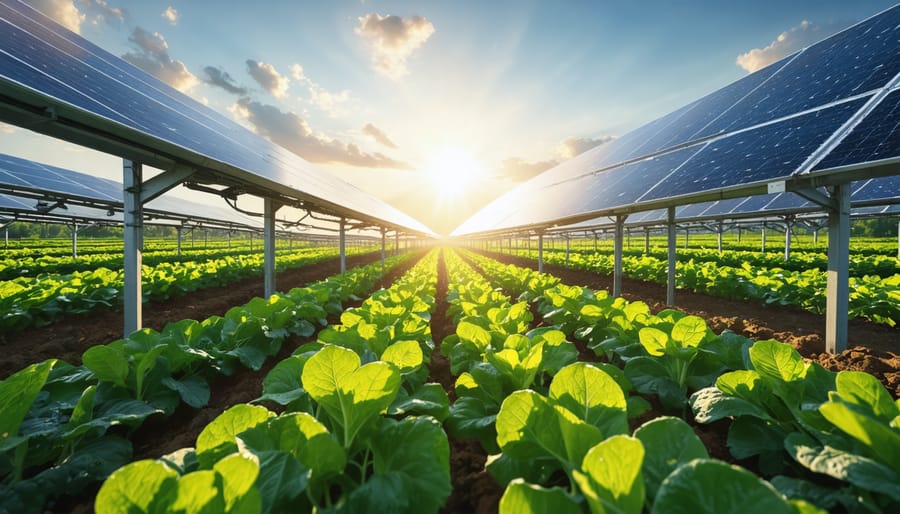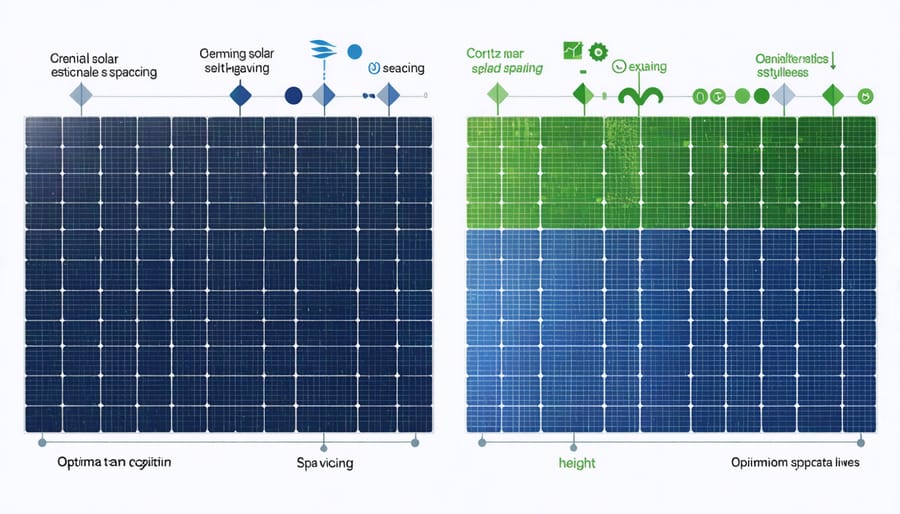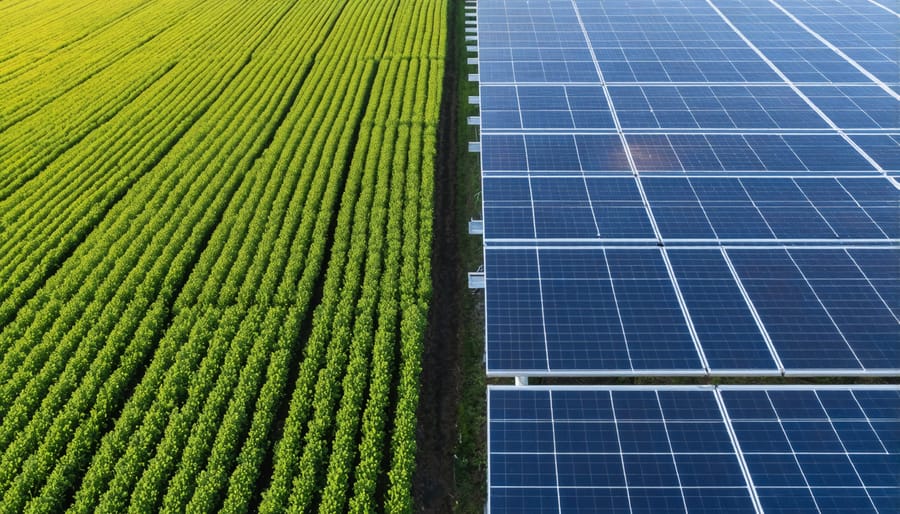Smart Zoning Makes Your Solar Farm and Crops Work Together

Solar farm zoning represents a critical intersection of renewable energy advancement and land-use management across Europe’s agricultural landscape. As regions accelerate their transition to sustainable energy, the strategic placement of solar installations on farmland demands careful consideration of both regulatory frameworks and agricultural preservation.
Modern solar farm zoning regulations balance energy production targets with food security concerns, creating opportunities for dual-use developments that maintain agricultural productivity while generating clean energy. These innovative approaches, particularly prevalent in countries like Germany and France, demonstrate how thoughtful zoning policies can support both energy independence and sustainable farming practices.
European municipalities increasingly adopt sophisticated zoning frameworks that specify setback requirements, height restrictions, and land-use ratios for solar installations. These regulations typically mandate environmental impact assessments, grid connection studies, and detailed land management plans before project approval. Understanding these requirements early in the planning process proves essential for successful solar farm development.
For landowners and developers, navigating these zoning requirements demands careful attention to local regulations while maximizing land-use efficiency. Strategic planning must account for soil quality preservation, biodiversity protection, and agricultural continuation – key factors that influence zoning approval across European jurisdictions.
The Dual-Use Revolution in European Agriculture
What Are Agrivoltaic Systems?
Agrivoltaic systems represent an innovative approach that’s rapidly transforming traditional farming practices across Europe. These systems combine solar power generation with agricultural production on the same land, creating a dual-use scenario that maximizes land efficiency. By mounting solar panels at specific heights and angles above crops, agrivoltaic installations enable farmers to maintain their agricultural activities while generating clean energy.
These hybrid systems are carefully designed to ensure optimal light distribution for both energy production and plant growth. The panels provide partial shade that can benefit certain crops, especially in regions experiencing increased heat stress due to climate change. Additionally, the infrastructure can offer protection against extreme weather events and help conserve soil moisture.
Modern agrivoltaic installations typically feature adjustable panels that can be optimized for different growing seasons and crop types. This flexibility allows farmers to adapt their systems throughout the year, ensuring maximum efficiency in both energy generation and agricultural yield. The approach has proven particularly successful with shade-tolerant crops, berries, and certain vegetables, demonstrating that sustainable energy production and food security can effectively coexist.

Benefits of Agricultural Solar Zoning
Properly zoned agricultural solar installations offer multiple advantages for both farmers and energy producers. When integrated as hybrid solar systems, these installations can optimize land use while maintaining agricultural productivity. Farmers benefit from additional income streams through energy generation, creating financial stability during challenging growing seasons.
Well-planned solar zoning preserves prime agricultural land while utilizing less productive areas for energy generation. This approach enables dual-land use, where certain crops or grazing animals can coexist beneath elevated solar panels. The panels themselves can provide beneficial shade for heat-sensitive crops and protect soil from excessive evaporation.
From an environmental perspective, agricultural solar zoning helps reduce carbon emissions while maintaining food production capacity. It also creates opportunities for innovative farming techniques, such as agrivoltaics, where specific crop varieties are selected to thrive in the modified microclimate created by solar installations.
Additionally, proper zoning ensures that solar installations respect local infrastructure, maintain appropriate setbacks from property lines, and preserve scenic rural landscapes, making them more acceptable to local communities.
Essential Zoning Considerations for Hybrid Solar Farms
Land Use Optimization
Modern solar farms are increasingly adopting innovative approaches to maximize land utilization through agrivoltaic systems. These dual-use strategies enable agricultural activities to continue beneath and between solar panels, creating synergistic benefits for both energy production and farming operations.
Successful land use optimization begins with careful panel placement and spacing. Elevated mounting systems, typically ranging from 2.5 to 4 meters high, allow farm machinery to operate underneath while providing adequate sunlight for crop growth. Strategic row spacing ensures sufficient light reaches the ground level, with some installations incorporating tracking systems that adjust panel angles throughout the day.
European farmers have found particular success with sheep grazing between solar arrays, as the animals naturally maintain vegetation while benefiting from shade during hot summer months. Other viable options include growing shade-tolerant crops like certain varieties of berries, herbs, and vegetables that thrive in partial sunlight conditions.
Water management also plays a crucial role in optimization. Solar panels can help reduce evaporation and create beneficial microclimates for certain crops. Some installations incorporate rainwater harvesting systems, collecting runoff from panels for irrigation purposes.
To achieve optimal results, land use planning should consider local climate conditions, soil quality, and specific agricultural needs. Regular monitoring and adjustment of both solar and agricultural components ensure sustained productivity and efficiency, making dual-use solar farms an increasingly attractive option for European landowners.

Environmental Impact Assessment
Environmental Impact Assessments (EIAs) play a crucial role in determining the viability and sustainability of solar farm projects across Europe. These assessments evaluate multiple ecological factors, including impacts on local wildlife, vegetation, soil quality, and water resources.
Key considerations include the analysis of habitat disruption, particularly for ground-nesting birds and pollinator species. Solar developers must conduct thorough biodiversity surveys throughout different seasons to understand migration patterns and breeding cycles. The assessment also examines soil erosion risks and drainage patterns, especially important in agricultural areas where dual land use is planned.
Visual impact analysis forms another critical component, measuring how the installation affects the landscape character and local viewsheds. This includes studying glare potential and implementing appropriate screening measures through strategic vegetation placement.
Modern EIAs increasingly focus on positive environmental contributions, such as creating wildlife corridors between panel rows and establishing pollinator-friendly vegetation. Many successful projects incorporate sheep grazing or apiaries, demonstrating effective land-sharing approaches.
The assessment process typically involves consultation with local environmental agencies, conservation groups, and community stakeholders. Developers must present mitigation strategies for identified impacts and outline long-term environmental monitoring plans. This comprehensive approach ensures solar farms not only generate clean energy but also contribute positively to local ecosystems and biodiversity goals.
Technical Infrastructure Requirements
The successful implementation of a solar farm requires careful attention to technical infrastructure requirements that extend beyond the solar panels themselves. Essential components include robust electrical systems with appropriate inverters, transformers, and switchgear designed to handle the farm’s projected power output. The site must feature a comprehensive grounding system and lightning protection to safeguard expensive equipment and ensure operational safety.
Grid connection infrastructure demands particular consideration, including substations and transmission lines capable of delivering generated power to the main electrical grid. Modern monitoring systems and smart meters are crucial for performance tracking and compliance with European grid codes. Additionally, access roads must be constructed to support both initial installation and ongoing maintenance, while security fencing and surveillance systems protect the investment.
Proper drainage systems help prevent water accumulation and soil erosion, which could compromise foundation stability. Cable trenches and conduit systems must be carefully planned to minimize power losses and facilitate future maintenance. The site should also incorporate weather monitoring stations to optimize performance and predict output fluctuations.
For agricultural integration, specialized mounting systems that allow sufficient ground clearance for farming activities are essential. These systems must be robust enough to withstand local weather conditions while maintaining optimal panel orientation for maximum energy yield.
Regulatory Framework and Compliance
Current European Guidelines
Across Europe, European regulations for solar farm zoning vary significantly by country, though recent EU directives have established baseline standards for sustainable land use. France leads with its agrivoltaic framework, requiring solar installations to maintain at least 70% of the original agricultural productivity. Germany implements a dual-use approach, mandating minimum light penetration for crops while optimizing solar panel positioning.
The Netherlands focuses on spatial planning integration, requiring solar farms to incorporate biodiversity measures and maintain local ecosystem balance. Italy’s recent guidelines emphasize the protection of high-value agricultural land, directing solar developments toward marginal or abandoned areas.
Most EU member states now require environmental impact assessments before approval, with particular attention to soil quality preservation and wildlife corridors. Common requirements include:
– Minimum distances from residential areas
– Maximum ground coverage ratios
– Mandatory biodiversity management plans
– Storm water management systems
– Visual impact mitigation measures
– Agricultural co-use documentation
These guidelines increasingly promote innovative solutions like elevated mounting systems for continued farming activities and smart tracking systems that optimize both energy generation and crop growth. Local authorities retain significant influence over specific zoning requirements, though they must align with national and EU-level sustainability objectives.
Securing Necessary Permits
Securing permits for a solar farm installation involves a structured process that requires careful attention to detail and compliance with local regulations. Begin by conducting a preliminary consultation with your local planning authority to understand specific requirements for your area. This initial meeting will help identify necessary documentation and potential challenges.
Next, prepare and submit a detailed planning application that includes site plans, environmental impact assessments, and grid connection proposals. Many European municipalities require comprehensive documentation about the proposed installation’s visual impact, biodiversity considerations, and agricultural land use implications.
Key permits typically include:
– Land use change authorization
– Building permits
– Environmental permits
– Grid connection approval
– Agricultural land conversion permits (where applicable)
Engage early with utility companies to secure grid connection agreements and necessary technical approvals. This process can take 3-6 months, depending on your location and project scope. Consider hiring a local planning consultant familiar with renewable energy projects to navigate complex regulations and increase approval chances.
Maintain open communication with neighboring property owners throughout the permitting process. Their support can significantly influence the approval timeline. Document all correspondence with authorities and keep detailed records of submissions and approvals.
Remember that some regions require additional permits for specific circumstances, such as heritage site proximity or protected species presence. Always verify current requirements with local authorities, as regulations frequently evolve to accommodate growing renewable energy demands.

Implementation Best Practices
Successful implementation of solar farm zoning requires careful attention to several key practices that ensure optimal performance and community acceptance. Begin by conducting comprehensive site assessments, including soil quality analysis, solar radiation measurements, and topographical surveys. These assessments should account for both agricultural needs and solar generation potential.
Establish clear boundaries and buffer zones between solar installations and neighbouring properties. A minimum setback of 10-15 metres is typically recommended, with additional consideration for visual impact mitigation through strategic landscaping and natural screening.
Design your layout to maximise both solar efficiency and agricultural use. Consider mounting heights that allow for machinery access and crop growth, typically 2.5-3 metres minimum clearance. Implement tracking systems that optimise solar capture while minimising shadow impact on crops.
Develop a detailed land management plan that outlines maintenance schedules for both solar equipment and agricultural activities. This should include protocols for cleaning panels, vegetation management, and crop rotation strategies. Regular monitoring of soil health and biodiversity indicators helps maintain land quality.
Engage early and continuously with local stakeholders, including farming communities, environmental groups, and municipal authorities. Transparent communication about project benefits and mitigation measures helps build trust and support. Document all consultations and incorporate feedback into project plans.
Implement robust drainage systems that prevent soil erosion and manage water runoff effectively. Consider using permeable ground cover between panel rows and installing monitoring systems to track soil moisture levels.
Create detailed documentation for maintenance procedures, emergency responses, and end-of-life decommissioning plans. This should include clear guidelines for both agricultural and solar maintenance teams to work safely and efficiently together.
Establish performance monitoring systems that track both energy generation and agricultural yields. Regular data analysis helps optimise the hybrid system’s overall efficiency and supports continuous improvement of operations.
Remember to review and update practices regularly to align with evolving regulations and technological advancements in both solar and agricultural sectors.
The future of solar farm zoning in Europe stands at a crucial intersection of agricultural preservation and renewable energy expansion. As we’ve explored throughout this article, successful solar farm implementation requires careful consideration of local regulations, environmental impact assessments, and stakeholder engagement. The growing trend toward agrivoltaics presents particularly promising opportunities for European landowners, offering dual-use solutions that maintain agricultural productivity while generating clean energy.
Looking ahead, we can expect continued evolution in zoning regulations as municipalities adapt to increasing demand for solar installations. The European Union’s commitment to renewable energy targets will likely drive further standardization of zoning practices across member states, potentially streamlining the approval process for solar farm projects. However, maintaining balance between energy production and land preservation will remain paramount.
For property owners and developers considering solar farm projects, early engagement with local authorities and thorough preparation of documentation will continue to be essential for success. The integration of smart technologies and innovative design solutions will help optimize land use and increase project acceptance rates.
As Europe moves toward its 2030 and 2050 climate goals, solar farm zoning will play an increasingly important role in shaping our energy landscape. By following established best practices and staying informed about regulatory requirements, stakeholders can contribute to a sustainable future while ensuring profitable and compliant solar installations.
Leave a Reply